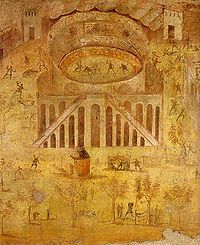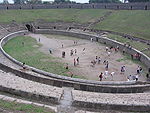
Amphitheatre of Pompeii
Encyclopedia



Roman amphitheatre
Roman amphitheatres are amphitheatres – large, circular or oval open-air venues with raised seating – built by the Ancient Romans. They were used for events such as gladiator combats, chariot races, venationes and executions. About 230 Roman amphitheatres have been found across the area of the...
. It is located in the ancient Roman city of Pompeii
Pompeii
The city of Pompeii is a partially buried Roman town-city near modern Naples in the Italian region of Campania, in the territory of the comune of Pompei. Along with Herculaneum, Pompeii was destroyed and completely buried during a long catastrophic eruption of the volcano Mount Vesuvius spanning...
, and was buried by the eruption of Vesuvius in 79 CE, that also buried Pompeii itself, and neighbouring Herculaneum
Herculaneum
Herculaneum was an ancient Roman town destroyed by volcanic pyroclastic flows in AD 79, located in the territory of the current commune of Ercolano, in the Italian region of Campania in the shadow of Mt...
.
Built around 70 BCE, the current amphitheatre was the first Roman
Ancient Rome
Ancient Rome was a thriving civilization that grew on the Italian Peninsula as early as the 8th century BC. Located along the Mediterranean Sea and centered on the city of Rome, it expanded to one of the largest empires in the ancient world....
amphitheatre
Amphitheatre
An amphitheatre is an open-air venue used for entertainment and performances.There are two similar, but distinct, types of structure for which the word "amphitheatre" is used: Ancient Roman amphitheatres were large central performance spaces surrounded by ascending seating, and were commonly used...
to be built out of stone, previously, they had been built out of wood. The next Roman amphitheatre to be built from stone would be the Colosseum
Colosseum
The Colosseum, or the Coliseum, originally the Flavian Amphitheatre , is an elliptical amphitheatre in the centre of the city of Rome, Italy, the largest ever built in the Roman Empire...
in Rome
Rome
Rome is the capital of Italy and the country's largest and most populated city and comune, with over 2.7 million residents in . The city is located in the central-western portion of the Italian Peninsula, on the Tiber River within the Lazio region of Italy.Rome's history spans two and a half...
, which postdates it by over a century. It was called a spectacula and not an amphitheatrum, since the latter term was not yet in use. It was built with the private funds of Quinctius Valgus and Marcius Porcius.
Around AD 59 CE, a deadly brawl occurred between Pompeians and Nuceria residents in the amphitheatre during games, which resulted in banning the events for 10 years.
Amongst other events, it hosted gladiatorial games, which owing to the preservation of Pompeii has given insights into the gladiator
Gladiator
A gladiator was an armed combatant who entertained audiences in the Roman Republic and Roman Empire in violent confrontations with other gladiators, wild animals, and condemned criminals. Some gladiators were volunteers who risked their legal and social standing and their lives by appearing in the...
culture of Rome.
The amphitheatre's design is seen by some modern crowd control specialists as near optimal. Its washroom, located in the neighbouring palaestra
Palaestra
The palaestra was the ancient Greek wrestling school. The events that did not require a lot of space, such as boxing and wrestling, were practised there...
has also been cited as an inspiration for better bathroom design in modern stadiums.
Modern uses
Aside from being a historical landmark, and an item of study to archaeologists, the amphitheatre has been used for other things in modern days.Pink Floyd
Pink Floyd
Pink Floyd were an English rock band that achieved worldwide success with their progressive and psychedelic rock music. Their work is marked by the use of philosophical lyrics, sonic experimentation, innovative album art, and elaborate live shows. Pink Floyd are one of the most commercially...
filmed a video and concert film (Pink Floyd: Live at Pompeii
Pink Floyd: Live at Pompeii
Pink Floyd: Live at Pompeii is a 1972 film featuring Pink Floyd performing six songs in the ancient Roman amphitheatre in Pompeii, Italy. It was directed by Adrian Maben and recorded in the month of October using studio-quality 24-track recorders without a live audience.The performances of...
) in the amphitheatre.
Sources
- BBC, "Pompeii Art and Architecture Gallery", Joanne Berry (accessed 7 May 2009)
- History Channel, The Most (2001), episode "Family Business"
- 'CSO: Security and Risk', "Modern Crowd Control Lessons (from Ancient Pompeii)", Scott Berinato, 18 May 2007 (accessed 7 May 2009)
- Pink Floyd: Live at Pompeii
- University of Chicago, "Amphitheatrum", James Grout, 'Encyclopaedia Romana' (accessed 7 May 2009)

